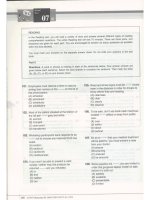07-Files
Bạn đang xem bản rút gọn của tài liệu. Xem và tải ngay bản đầy đủ của tài liệu tại đây (290.31 KB, 22 trang )
Reading Files
Chapter 7
Software
Input
and Output
Devices
Central
Processing
Unit
Main
Memory
Secondary
Memory
It is time to go
find some Data to
mess with!
What
Next?
if x< 3: print
From Sat Jan 5 09:14:16 2008
Return-Path: <>
Date: Sat, 5 Jan 2008 09:12:18 -0500
To:
From:
Subject: [sakai] svn commit: r39772 - content/branches/
Details: />...
Files R Us
File Processing
•
A text file can be thought of as a sequence of lines
From Sat Jan 5 09:14:16 2008
Return-Path: <>
Date: Sat, 5 Jan 2008 09:12:18 -0500
To:
From:
Subject: [sakai] svn commit: r39772 - content/branches/
Details: />Opening a File
•
Before we can read the contents of the file we must tell Python which
file we are going to work with and what we will be doing with the file
•
This is done with the open() function
•
open() returns a “file handle” - a variable used to perform operations
on the file
•
Kind of like “File -> Open” in a Word Processor
Using open()
•
handle = open(filename, mode)
•
returns a handle use to manipulate the file
•
filename is a string
•
mode is optional and should be 'r' if we are planning reading the file
and 'w' if we are going to write to the file.
/>fhand = open('mbox.txt', 'r')
What is a Handle?
>>> fhand = open('mbox.txt')
>>> print fhand
<open file 'mbox.txt', mode 'r' at 0x1005088b0>
When Files are Missing
>>> fhand = open('stuff.txt')
Traceback (most recent call last):
File "<stdin>", line 1, in <module>
IOError: [Errno 2] No such file or directory: 'stuff.txt'
The newline
Character
•
We use a special character to
indicate when a line ends
called the "newline"
•
We represent it as \n in strings
•
Newline is still one character -
not two
>>> stuff = 'Hello\nWorld!'
>>> stuff
'Hello\nWorld!'
>>> print stuff
Hello
World!
>>> stuff = 'X\nY'
>>> print stuff
X
Y
>>> len(stuff)
3









